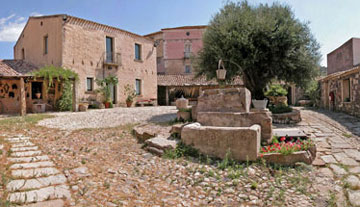
Omu Axiu
I’m having lunch at the Caffe degli Spiriti, a charming eatery located on the Bastione di Sam Remy with a panoramic view over the town. The meal begins with bread: the delicious bread of Sardegna.
The bread here is a bread not to be found elsewhere. Boasting of tradition and craftsmanship, the flat pane carasau bread is a crunchy variety made of durum wheat, seed corn, baking power, and water. Baked thin inside a brick oven, the warm bread is sometimes dressed with olive oil and salt.
Not only is the bread of Sardinia amazing, but so is the seafood. The seafood and the cheese and the bread and the wine. The tomatoes and the olives and the honey and the wild boar. Mama Mia. The food alone is worth the trip to Sardinia, not to mention all of the other wonders of this mystic island.
Finishing this meal, I’m once again sustained for the day. Heading outside to the hammock swing, I kick back and relax, closing my eyes and listening to the chirp of excited birds. These birds are happy.
I know just how they feel.
The mountains, the plains, the rivers, the coast, the sea. This place has it all. It also has numerous archaeological sites, including my favorite: Nora.
Founded around 700 B.C., Nora is on the southwest part of the island. Evoking images of people long gone, the site is an incredible testament to hard work and craftsmanship that endures the ravages of time, weather, and civilization. Framed by the seascape, Nora includes the ruins of mosaic-floored buildings, thermal baths, the Forum, a temple, and a theatre, actually still used during summer months.
Nora’s story stretches back 3,000 years, and this place was once inhabited by the Nuraghi culture. Nuraghi is a term used to describe not only the long-ago dwellers of these ruins; it’s also the word used to describe the more than 7,000 well-preserved stone towers dotting the landscape of Sardinia. The first settlers of Sardinia started piecing together their fortress homes — the nuraghi — around 1500 B.C. These stone buildings — mini castles of sorts — are centered around a main tower or fortress, and are testaments of preservation. Also to be found on the island are the intriguing “tombs of the giants”: monolithic burial chambers.
Here, in Sardinia, a place where flowers grow from stone, it’s possible to connect with the past as it is nowhere else.
I’m at OmuAxiu, a farmhouse/museum located in Orroli. This house has been in the family — the same family — since 1500. OmuAxiu is the home of the family, and it’s also the home of a restaurant and museum. Upstairs is an embroidery museum, with delicate linens and other heirlooms. Downstairs is the museum of farming tools. The restaurant is located inside a spacious room once used for grinding cereals. The meal here is amazing, and the family dishes up dinner in traditional 19th century costumes. Everything served here has been grown here, on this land, by this family.
Today is the birthday of the family matriarch, and she’s 79. She looks at least twenty years younger. Sardinia is known for the longevity of its residents, with more people over 100, proportionately, on this island than anywhere else in the world.
Some attribute the longevity of Sardinian people to the no-stress lifestyle, the food, the air, the water, the wine, the exercise of living off the land. It’s all that and a mysterious something else, and I can see why these Sardinian centenarians smile.

